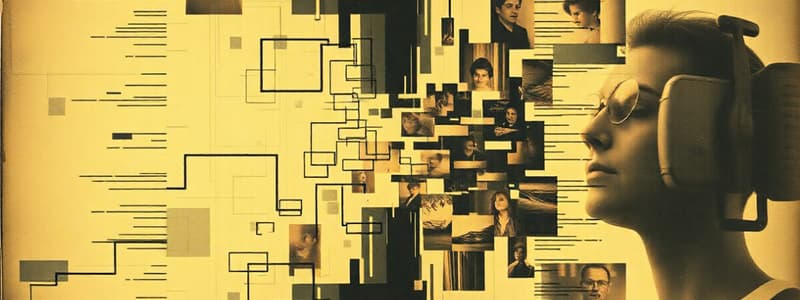Podcast
Questions and Answers
Which type of noise is most directly related to misinterpretations arising from differing cultural backgrounds between a sender and a receiver?
Which type of noise is most directly related to misinterpretations arising from differing cultural backgrounds between a sender and a receiver?
- Physical noise
- Technical noise
- Psychological noise
- Social noise (correct)
In communication, what is the primary difference between distortion and noise?
In communication, what is the primary difference between distortion and noise?
- Distortion occurs during encoding/decoding, while noise is environmental interference. (correct)
- Distortion is caused by external factors, while noise is caused by internal factors.
- Distortion can be reduced by redundancy, while noise cannot.
- Distortion affects the clarity of a message, while noise affects its arrival.
A project manager sends an email with critical instructions to their team, but some team members miss key details due to a combination of fatigue and pre-existing biases. This scenario best illustrates the impact of:
A project manager sends an email with critical instructions to their team, but some team members miss key details due to a combination of fatigue and pre-existing biases. This scenario best illustrates the impact of:
- Technical noise
- Social noise
- Psychological noise (correct)
- Physical noise
What communication strategy is most effective in reducing the impact of noise?
What communication strategy is most effective in reducing the impact of noise?
An individual selectively focuses on information that confirms their existing beliefs and ignores contradictory evidence during a presentation. This is an example of:
An individual selectively focuses on information that confirms their existing beliefs and ignores contradictory evidence during a presentation. This is an example of:
Which of the following is primarily influenced by personal differences such as racial origin, religious beliefs, and socio-economic status?
Which of the following is primarily influenced by personal differences such as racial origin, religious beliefs, and socio-economic status?
A company's internal communication suffers when employees from different departments struggle to understand each other due to jargon specific to each department. What type of communication barrier is primarily at play?
A company's internal communication suffers when employees from different departments struggle to understand each other due to jargon specific to each department. What type of communication barrier is primarily at play?
Considering the role of a communicator, what strategy is most effective for capturing and maintaining a recipient's focus on the central message?
Considering the role of a communicator, what strategy is most effective for capturing and maintaining a recipient's focus on the central message?
During a crucial presentation, the speaker's anxiety leads to rushed speech and disorganized thoughts, causing the audience to misinterpret key information. Which type of noise is most evident in this scenario?
During a crucial presentation, the speaker's anxiety leads to rushed speech and disorganized thoughts, causing the audience to misinterpret key information. Which type of noise is most evident in this scenario?
In a global team, a message is misinterpreted because the recipient's understanding of a phrase differs from the sender's due to cultural context. This misinterpretation is best described as:
In a global team, a message is misinterpreted because the recipient's understanding of a phrase differs from the sender's due to cultural context. This misinterpretation is best described as:
Flashcards
Distortion
Distortion
Loss of meaning in communication during encoding and decoding stages.
Noise
Noise
Distractions that interfere with communication clarity and accuracy.
Physical Noise
Physical Noise
External distractions like voices or traffic that block communication.
Technical Noise
Technical Noise
Signup and view all the flashcards
Social Noise
Social Noise
Signup and view all the flashcards
Psychological Noise
Psychological Noise
Signup and view all the flashcards
Redundancy in Communication
Redundancy in Communication
Signup and view all the flashcards
Factors Causing Distortion
Factors Causing Distortion
Signup and view all the flashcards
Perception
Perception
Signup and view all the flashcards
Selective Perception
Selective Perception
Signup and view all the flashcards
Study Notes
Communication Problems & Distortion
- Distortion: Loss of meaning during communication, occurring during encoding and decoding.
- Noise: Interference and distractions hindering communication, impacting accuracy, clarity, and message delivery.
- Physical noise: External distractions like people talking, traffic.
- Technical noise: Issues like bad handwriting, phone line crackles.
- Social noise: Differences in personality, culture, or outlook between sender and receiver.
- Psychological noise: Emotional factors like anger, fear, prejudice, or nervousness.
- Reducing noise: Employing redundancy (multiple communication channels) to ensure message delivery.
Personal Differences Affecting Communication
- Individual factors: Diverse traits, experiences, and backgrounds influencing communication (distortion/noise):
- Racial/ethnic/regional origins
- Religious beliefs
- Social class/socio-economic background
- Education/training
- Age
- Sex
- Occupation
- Personality traits (introvert/extrovert, etc.)
- Intelligence (mental ability, linguistic/numerical skills)
Perception & Selective Perception
- Perception: The brain's process of selecting, sorting, organizing, and interpreting sensory data to form meaningful information.
- Selective perception: The subconscious mind choosing relevant/irrelevant stimuli, leading to potential message distortion.
- Attention: Focusing on selected stimuli, crucial for both sender & receiver.
- Receiver: Minimizing distractions, acknowledging potential message parts being ignored.
- Sender: Attracting/holding receiver's attention to key message points.
Studying That Suits You
Use AI to generate personalized quizzes and flashcards to suit your learning preferences.




